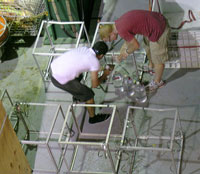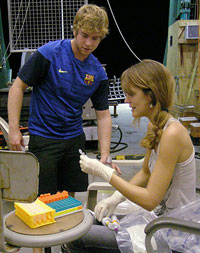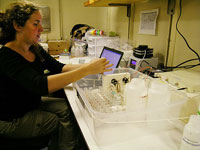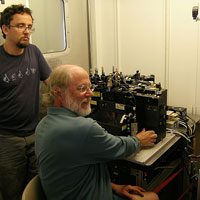- C-MORE Home
- What is Microbial Oceanography?
- What is C-MORE?
- Research
- • Research Cruises
- » BioLINCS
- Home
- Cruise Participants
- Instruments Used
on the Cruise - Nitrogen Cycling
- Marine Microbes
- Cruise Blog
- Data Archive
- Education & Outreach
- People
- Publications
- Image Library
- Contact Us
| |||||||||||||||||||||||||||||||||||
BioLINCS Cruise Blog
Friday, September 16, 2011
|
Ariel Rabines (left) and Peter Alpert prepare “gas arrays” (metal frames holding glass incubation bottles) for a night-time deployment. Both Ariel and Peter have helped with a variety of deck and laboratory work. Peter has volunteered for many tasks in addition to collecting his own samples for later analysis on shore. |
|
Ben Rubin helps postdoctoral fellow Daniela del Valle collect water samples from her incubation experiment for later analysis in the laboratory. Peter started as a CMORE intern just days before the cruise began. |
|
During the cruise, Mariona Segura has worked tirelessly to analyze the chemistry of thousands of water samples. The results of her chemical analyses are used in nitrogen-cycling experiments, and also help the molecular biologists determine the best places to collect samples for DNA analysis. |
|
Denis Bombar (left) watches as Ger van den Engh adjusts his influx flow cytometer (IFC). Being exposed to cutting-edge tools and knowledgeable colleagues has given several of the scientists on this cruise new ideas for future research and collaboration. |
This morning started out showery, but we’ve gotten back into pleasant sailing weather this afternoon, with trade winds of about 12 to 18 knots—enough to make picturesque whitecaps, but not enough to “rock the boat” or make it difficult to work on deck.
Although one of the motion sensors on the Environmental Sample Processor (ESP) is no longer working, the rest of the instrument seems to be doing great. Just today, Julie Robidart posted a new set of plots showing dramatic changes in the types of genes and of microbes that the ESP has detected over the course of the cruise. There is a fair amount of head-scratching over what these plots mean, but it’s great to see the ESP working as planned.
It feels as if the cruise as a whole has gone quite well so far. Among the researchers, there’s a palpable sense that we have turned the corner and are beginning the home stretch of the cruise. However, we are all well aware that there’s still a lot of work to do, and that we still have to get many of our drifting instruments back on board the ship. In fact, two of our most challenging instrument recoveries are yet to come.
Although people are taking a few minutes to relax here and there, I don’t see a lot of signs that people are slowing down. Many researchers are pushing ahead with new, more complex incubations and experiments. For example, the team from MIT, having incubated microbes around the clock for almost a week, are now considering expanding their experiment to collect samples from three different depths and two light levels, all in their one little incubation box on the upper deck.
One thing that strikes me is how, over the course of the cruise, we’ve become more efficient and are better able to work together as a team. Partly this is because we have a better sense of what needs to be done. This is especially true for the members of the research team who are less experienced in oceanographic research, such as the interns, Ariel Rabines of UC Santa Cruz (UCSC) and Ben Rubin of the University of Hawai‘i (UH), as well as Peter Alpert of Stonybrook University and myself.
Over the last week, we have all been trained on daily tasks such as CTD casts, water processing, and chemical analysis. This gives the other researchers and marine operations staff a chance to work on more complicated tasks, or get a well-deserved rest. Over the past week, we have been learning how to work with the marine operations staff and the ship’s crew, and they are learning how to work with us. A lot of this is a matter of building confidence and trust. We, the inexperienced crew members, needed to develop the confidence to be useful around the ship, and the scientists and the ship’s crew needed to develop the trust to let us be involved in handling precious instruments and data (not to mention being safe in a constantly changing ship-board environment).
As the cruise has progressed, I feel as if the experienced researchers on board have also found unexpected ways to collaborate, and to find synergy in each other’s work. For example, researchers from the University of Hawai‘i (UH) are performing most of the physical chemistry experiments on board, such as analyzing samples of seawater for nitrogen gas or ammonium. But the UH researchers are finding that researchers from UCSC and MIT, who work with genetic material, are often interested in sharing samples. This gives the gives the physical chemists a better idea of what microbes might be causing the chemical changes that they are measuring, and it gives the gene researchers a better idea of the environment that their microbes are living in.
Another unexpected benefit is that researchers are helping one another when things do not go as planned. For example, the genomic researchers from MIT encountered unexpected difficulties in measuring chemical changes in their incubators, but were helped out by Mariona Segura, who makes similar measurements for the University of Hawai‘i.
During a cruise like this, the exchange of ideas is at least as important as the exchange in water samples and data. John Waterbury has collected opportunistic samples from a number of incubation experiments on the ship. Back on shore, he will try to culture the microbes that were favored by these experiments. In the mean time, however, his first-hand knowledge of the basic biology of the microbes we are studying has proven invaluable to many of the researchers on board.
Similarly, Ger van den Engh has inspired several researchers, including Mariona Segura and Denis Bombar, to work with him to expand the possible applications of the influx flow cytometer (IFC) in marine microbial research.
Over the next 24 hours, we will need all of the efficiency and teamwork we can get. Tomorrow morning at 4 AM we will recover the University of Hawaii’s Lagrangian sediment traps, which have been drifting around the ocean since September 9. We will be bringing on deck 12 arrays, each from a different depth. Each array consists of 12 sediment traps. The particles and fluids from each of these traps will be split into subsamples and subjected to up to a dozen different types of chemical and genomic analysis. A little math will tell you that tomorrow will be a long, busy day.
[ Top of Page ]







